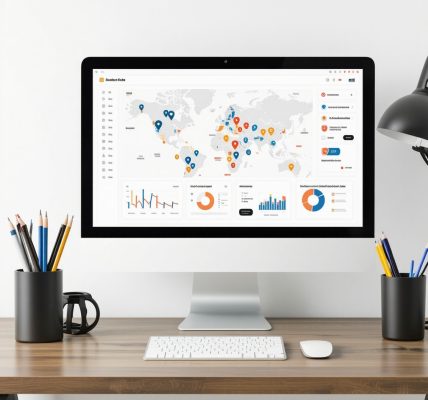Unlocking the Potential: Why Your GMB Category Choice Shapes Local Success
Choosing the right Google My Business (GMB) category isn’t just a formality; it’s a strategic cornerstone that can dramatically enhance your local business visibility. The GMB category dictates how Google understands your business and matches it with relevant local queries, influencing your placement in the coveted Local 3-Pack and Google Maps results. This article delves into the best GMB categories to maximize local business exposure, drawing on expert insights and real-world applications to help you outshine competitors in 2025’s increasingly competitive local SEO landscape.
Precision Matters: Navigating Primary vs. Secondary GMB Categories
Google allows one primary category and multiple secondary categories, but the primary category wields the most influence. Selecting a primary category that precisely defines your core service or product is essential. For instance, a boutique coffee shop should prioritize categories like “Coffee Shop” or “Café” rather than a broad term like “Restaurant” to attract the most relevant local traffic. Secondary categories should supplement and expand your business scope, such as “Bakery” or “Breakfast Restaurant,” to capture diverse search intents.
How Do Different GMB Categories Impact Local Search Rankings?
The choice of category affects not only keyword relevance but also competition levels and customer expectations. Categories aligned closely with user search intent improve click-through rates and conversion potential. For example, a plumber listing under “Emergency Plumber” can attract urgent service seekers more effectively than a generic “Plumber” category. Additionally, Google’s algorithm considers category consistency with business descriptions, reviews, and photos, enhancing trustworthiness and ranking potential.
Top Performing GMB Categories Across Key Industries
Retail: Categories like “Clothing Store,” “Electronics Store,” and “Furniture Store” excel when paired with descriptive secondary categories such as “Men’s Clothing” or “Home Decor.” These precise designations help Google surface your listing to shoppers with specific needs.
Service Providers: For professionals like “Dentists,” “Lawyers,” or “Landscapers,” using detailed categories such as “Pediatric Dentist” or “Personal Injury Lawyer” refines search accuracy and attracts targeted clientele.
Hospitality: Restaurants, hotels, and cafes benefit from specialized categories like “Italian Restaurant,” “Boutique Hotel,” or “Coffee Shop,” combined with attributes like “Outdoor Seating” or “Free Wi-Fi” to entice local visitors.
Leveraging Semantic SEO and Local Intent with GMB Categories
Integrating Latent Semantic Indexing (LSI) keywords into your GMB business description and posts amplifies the effectiveness of your chosen categories. For example, a “Yoga Studio” might include terms like “meditation classes,” “wellness workshops,” and “mindfulness training” to signal comprehensive offerings to Google’s algorithm. This semantic enrichment complements category selection, improving your listing’s relevance for a broader range of localized search queries.
Expert Tip: Continuously Audit and Optimize Your GMB Profile for Category Relevance
Local SEO is dynamic. Regular audits to assess category performance and alignment with evolving services ensure sustained visibility. Tools and services specializing in GMB SEO audits can uncover category mismatches or emerging category opportunities to keep your profile optimized. For actionable insights on refining your Google Business listing, consider exploring expert GMB SEO audit techniques that drive measurable local search improvements.
Drive Engagement: Ready to Amplify Your Local Reach?
If you found these insights valuable, share your experiences with GMB category selection in the comments below or explore comprehensive strategies to dominate local search rankings through expert GMB ranking techniques. Your local business growth journey starts with the right category choice.
For deeper understanding of how Google categorizes businesses and its impact on local SEO, the official Google Business Profile categories documentation offers authoritative guidance directly from the source.
Balancing Breadth and Specificity: How to Choose Secondary Categories Strategically
While the primary category anchors your Google My Business (GMB) profile, secondary categories can enhance your visibility by broadening the scope of your listing without diluting relevance. For example, a dental practice can select “Dentist” as a primary category but include secondary categories such as “Cosmetic Dentist” or “Orthodontist” to capture diverse patient needs. However, overloading with irrelevant secondary categories can confuse Google’s algorithm and harm your ranking. The key is to select secondary categories that complement and expand on your core services without straying too far.
How Can Emerging GMB Features Amplify Your Category Strategy?
Google continues to evolve GMB features like service menus, product catalogs, and attributes that interact with category choices to boost local SEO. Leveraging these features in tandem with precise categories can create a richer listing experience and improve engagement. For instance, a restaurant listing under “Italian Restaurant” that uses the service menu feature to highlight “Gluten-Free Options” or “Outdoor Dining” will better satisfy specific user queries, increasing click-through rates and conversions. Integrating these dynamic elements requires ongoing monitoring and adjustment aligned with category strategy.
Harnessing User-Generated Content to Reinforce Category Relevance
Reviews, Q&A, and photos uploaded by customers contribute significantly to category validation. Encouraging customers to mention specific services or attributes in reviews can strengthen semantic signals associated with your categories. For example, a “Landscaper” who receives reviews highlighting “hardscaping” or “sustainable garden design” signals to Google a broader expertise aligned with potential secondary categories. Monitoring and responding to this user-generated content also builds trust and improves local ranking potential.
Integrating Citation Consistency with Your GMB Category Choices
Maintaining consistent business name, address, phone number (NAP), and category information across local citations fortifies your local SEO authority. Inconsistent categories across directories can confuse search engines and fragment your ranking signals. Utilizing expert citation management services ensures your GMB categories and related metadata remain uniform across platforms, enhancing local search performance. For practical citation management approaches, see expert GMB citation services for enhanced rankings.
What Are the Most Effective Ways to Monitor and Adapt Your GMB Categories Over Time?
Continuous performance tracking through tools like Google Analytics, Google Search Console, and specialized GMB SEO platforms is vital. These tools help you analyze which categories drive traffic, engagement, and conversions. Additionally, monitoring competitor category changes and local search trends can inform timely adjustments. Establish a schedule for quarterly or bi-annual audits to evaluate category effectiveness, identify emerging categories, and re-align your profile accordingly. This proactive approach ensures sustained competitive advantage in local search.
For further expertise on maximizing your Google Business listing performance, explore comprehensive Google Business listing optimization techniques that complement category management for optimal results.
According to Moz, local search ranking factors heavily weigh category relevance and consistency, reinforcing the importance of strategic category selection and ongoing optimization (Moz Local Search Ranking Factors 2023).
We invite you to share your thoughts or experiences regarding GMB category optimization in the comments below. Engage with our community to exchange insights and stay ahead in local SEO trends.
Decoding Google’s Algorithmic Nuances Behind GMB Category Weighting
Google’s local search algorithm employs intricate weighting mechanisms that prioritize GMB categories based on relevance, user intent, and historical performance data. Unlike a flat ranking system, the algorithm dynamically interprets category signals alongside behavioral metrics such as click-through rates, user engagement, and review sentiment. For example, research from Search Engine Land’s analysis of local ranking factors reveals that Google increasingly leverages AI-driven pattern recognition to match nuanced category definitions with hyper-localized queries, making precise category selection even more critical.
How Can Machine Learning Enhance GMB Category Optimization Over Time?
Machine learning models integrated within Google’s ecosystem continuously learn from user interactions to refine how categories influence local search outcomes. Businesses that dynamically adjust their GMB categories in response to emerging search trends and customer feedback benefit from improved ranking stability and relevance. Advanced SEO practitioners employ predictive analytics tools to anticipate category shifts and incorporate semantic clustering techniques, effectively future-proofing their local visibility strategy.
Moreover, leveraging Natural Language Processing (NLP) to analyze customer reviews and Q&A can unearth latent services and attributes that warrant inclusion as secondary categories or service menu items. This proactive approach aligns your GMB profile with evolving user lexicons, enhancing Google’s confidence in your business classification.
Integrating Multi-Channel Data to Fine-Tune Category Selection and Local SEO Impact
To transcend traditional category selection, savvy marketers integrate insights from diverse data streams — including social media analytics, competitor benchmarking, and local market research — to calibrate GMB categories with precision. For instance, correlating regional search volume data with demographic insights can inform the addition or removal of secondary categories, tailoring your presence to the most lucrative segments.
Additionally, synchronization of GMB category data with local citation profiles across platforms such as Yelp, Bing Places, and industry-specific directories ensures consistent signals that amplify domain authority. Discrepancies or outdated categories in any channel can dilute ranking efficacy, underscoring the need for centralized category management systems.
Advanced Troubleshooting: Diagnosing and Rectifying Category-Related Ranking Issues
Complex local SEO challenges often stem from subtle misalignments or conflicts within GMB categories. Common issues include overbroad category selection, inconsistent category usage across listings, or failure to update categories following business model changes. To diagnose these, experts utilize comprehensive audit frameworks combining GMB insights with third-party SEO tools that track category-related keyword performance and local SERP fluctuations.
In cases where category changes do not reflect promptly, understanding Google’s update latency and verification processes helps set realistic expectations and guides corrective actions. For example, submitting updated categories alongside refreshed business descriptions and enhanced multimedia content can accelerate indexing and improve category relevance signals.
What Role Does User Behavior Play in Validating or Challenging Your GMB Category Choices?
User behavior metrics such as bounce rates, direction requests, and call clicks serve as indirect validators for your chosen categories. Elevated engagement in listings with precise categories indicates alignment with user intent, whereas declining interactions may signal category misfit or emerging market shifts. Monitoring these signals allows businesses to iteratively refine their category strategy, maintaining a competitive edge in local search.
As you deepen your local SEO expertise, consider tapping into our advanced GMB optimization strategies to discover cutting-edge tactics that leverage category intelligence for maximum impact.
Embracing Continuous Intelligence: Dynamic GMB Category Evolution for Sustained Local Dominance
In an environment where Google’s local search algorithms continuously evolve, static GMB category strategies risk obsolescence. Proactively adapting your category selection informed by real-time analytics and emerging industry trends ensures your business remains optimally positioned in local search results. This approach transcends mere maintenance, transforming your profile into a living asset that reflects shifting consumer behaviors and market dynamics.
Deciphering Category Saturation: Strategies to Differentiate in Crowded Local Markets
High-competition sectors often witness extensive overlap in category usage, diluting individual business visibility. To counteract this, consider leveraging hyper-localized secondary categories or niche specializations that competitors overlook. For example, instead of simply “Bakery,” a business might emphasize “Gluten-Free Bakery” or “Artisanal Sourdough Bakery” to capture distinct search intent. Coupling this with targeted attributes and service menus refines listing granularity, enhancing discoverability among discerning local audiences.
How Can Predictive Analytics Drive Proactive GMB Category Adjustments?
Predictive analytics harnesses historical search data, seasonal fluctuations, and consumer sentiment analysis to forecast category relevance shifts. By integrating these insights, businesses can preemptively modify their GMB categories to align with anticipated demand patterns. Platforms specializing in local SEO analytics offer dashboards that visualize category performance trajectories, enabling swift, data-driven decisions. This preemptive tactic minimizes ranking volatility and capitalizes on emergent market opportunities before competitors react.
Elevating Local Authority Through Strategic Category Synergies
Establishing a coherent ecosystem of related categories and supporting content across your digital footprint amplifies your local authority signal. This multi-dimensional strategy involves aligning your GMB categories with website schema markup, localized blog content, and consistent social media messaging. Such semantic congruence fosters a robust topical relevance profile, which Google’s AI interprets as authoritative, directly impacting your local search prominence.
Expert Insight: Leveraging Google’s Business Profile API for Scalable Category Management
For businesses managing multiple locations or frequently updating service offerings, the Google Business Profile API provides an automated, scalable solution for category adjustments. This API enables bulk modifications, real-time synchronization, and detailed reporting, reducing manual overhead and ensuring consistent category accuracy across all listings. Integrating the API into your local SEO workflow empowers precision and agility in category optimization at scale.
Unlocking the Power of Customer Feedback Loops in Refining Category Strategy
Beyond passive review monitoring, actively soliciting customer input about your services can reveal latent category opportunities or misclassifications. Deploy surveys and feedback forms that inquire about specific services or experiences, then analyze linguistic patterns using NLP tools to detect emerging service trends. Incorporating these insights into your GMB categories and service menus keeps your profile aligned with actual customer perceptions and expectations, fostering authenticity and trust.
For comprehensive frameworks on advanced GMB profile management, consider consulting Search Engine Land’s authoritative guide on local SEO best practices, which offers nuanced tactics tailored for expert practitioners.
Engage with Us: Harness These Cutting-Edge GMB Category Strategies Today
Are you ready to transform your local SEO approach by embracing predictive analytics, API automation, and customer-driven category refinement? Share your challenges and successes in the comments or connect with our community of local SEO professionals to exchange high-level insights. Elevate your Google My Business presence to new heights with these advanced, data-driven category optimization techniques.
Frequently Asked Questions (FAQ)
What is the difference between primary and secondary GMB categories, and why does it matter?
The primary category is the main classification that defines your business’s core service or product, carrying the most weight in local search rankings. Secondary categories complement the primary by broadening your service scope without diluting relevance. Choosing precise primary categories ensures your business appears for the most relevant searches, while well-selected secondary categories capture additional, related search intents to maximize visibility.
How often should I review and update my GMB categories?
Regular audits every quarter or bi-annually are recommended to ensure your categories remain aligned with your evolving services and local search trends. Continuous monitoring helps identify category performance, emerging opportunities, or mismatches that could impact your ranking, allowing you to adapt proactively and maintain competitive advantage.
Can using too many secondary categories harm my local SEO?
Yes. Overloading your profile with irrelevant or loosely related secondary categories can confuse Google’s algorithm, potentially reducing your ranking. It’s essential to select only those secondary categories that genuinely complement and expand your core offerings without straying too far, preserving semantic relevance and user intent alignment.
How do user-generated reviews and Q&A influence my GMB category effectiveness?
Customer reviews and Q&A reinforce your category relevance by embedding semantic signals related to your services. Reviews mentioning specific offerings or attributes help Google validate and expand your category associations, improving local search accuracy. Actively encouraging detailed reviews and engaging with user content strengthens these semantic signals and builds trust.
What role does machine learning play in refining GMB category rankings?
Google’s machine learning algorithms analyze user behavior, engagement, and semantic cues to dynamically weigh category relevance. They learn from search patterns and feedback to improve matching between user queries and business categories. Businesses that adapt their categories based on data insights benefit from enhanced ranking stability and better alignment with evolving search intent.
How can I leverage emerging GMB features alongside categories to boost local SEO?
Integrating features like service menus, product catalogs, and attributes with your chosen categories enriches your listing and addresses specific user queries. For example, highlighting “Gluten-Free Options” under an “Italian Restaurant” category targets niche preferences. These dynamic elements increase engagement, improve click-through rates, and support your category strategy by providing detailed, relevant information.
Is consistency across local citations important for GMB category optimization?
Absolutely. Maintaining uniform business name, address, phone number (NAP), and category information across all local citations reinforces your local SEO authority. Inconsistent categories can dilute ranking signals and confuse search engines. Employing citation management ensures synchronized data that amplifies your profile’s credibility and improves search performance.
What advanced tools or APIs can help manage GMB categories effectively?
The Google Business Profile API enables scalable, automated management of categories for businesses with multiple locations or frequent updates. It supports bulk modifications, real-time synchronization, and reporting, reducing manual effort and ensuring consistency. This technology empowers precise and agile category optimization at scale, essential for sophisticated local SEO strategies.
How can predictive analytics inform proactive category adjustments?
Predictive analytics uses historical search data, seasonal trends, and consumer sentiment to forecast shifts in category relevance. By analyzing these insights, businesses can anticipate demand changes and adjust categories before ranking declines occur, capturing emerging opportunities and staying ahead of competitors in local search.
What should I do if my category changes do not reflect promptly on Google?
Google may experience update latency due to verification processes and indexing schedules. To expedite changes, update your business description, add fresh photos, and encourage new reviews alongside category modifications. Patience combined with these actions improves indexing speed and enhances the accuracy of category signals.
Trusted External Sources
Google Business Profile Categories Documentation: The official resource from Google offers authoritative and detailed information on available categories, best practices, and how categories influence local search, serving as the foundational guide for any GMB optimization effort.
Search Engine Land – Local SEO Best Practices: This publication provides in-depth analysis and expert strategies on local search ranking factors, including advanced category management, semantic SEO, and emerging trends that shape local visibility.
Moz – Local Search Ranking Factors 2023: Moz’s comprehensive research delivers data-driven insights on the weight of category relevance, consistency, and user engagement in local SEO, helping to prioritize optimization tasks effectively.
Google Business Profile API Documentation: A technical resource essential for developers and SEO professionals managing multiple listings, enabling scalable and precise category updates and profile enhancements.
Search Engine Land – Analysis of Google’s Local Ranking Algorithm: This expert article decodes Google’s algorithmic nuances and machine learning applications in local search, offering valuable context for understanding category weighting and optimization tactics.
Conclusion: Elevate Your Local SEO with Strategic GMB Category Mastery
Mastering Google My Business category selection is pivotal for dominating local search in 2025 and beyond. By choosing precise primary categories and thoughtfully curated secondary categories, businesses align closely with user intent and elevate their visibility in competitive local markets. Integrating semantic SEO, leveraging emerging GMB features, and maintaining citation consistency further amplify your local authority. Embracing data-driven approaches such as predictive analytics, machine learning insights, and API automation ensures your category strategy remains dynamic and future-proof.
Remember, your GMB category choices act as the digital signpost guiding customers directly to your doorstep. Regular audits, customer engagement, and continuous optimization cultivate a robust local presence that adapts to evolving search behaviors. Start applying these expert strategies today to unlock your business’s full local potential. Share your experiences, comment below, and explore our advanced resources to stay at the forefront of local SEO excellence.




I found the distinction between primary and secondary GMB categories especially insightful here. In my experience managing a small café, we initially went with the broader category “Restaurant,” and noticed our visibility wasn’t as targeted as we hoped. Switching to a more specific primary category like “Coffee Shop” and adding secondary ones such as “Bakery” made a huge difference in attracting the right crowd—people looking specifically for coffee and light breakfast options rather than full meals. The point about tying reviews and business descriptions closely to your chosen categories also resonated with me. Encouraging customers to mention precise offerings in their reviews seems to reinforce Google’s understanding of what we really do, which I’ve seen correlate with better rankings. I’m curious, though—have others experimented with adjusting their GMB categories seasonally or based on shifting services? For example, if your business offers a new service or product line temporarily, do you modify your categories accordingly, or stick with stable categories for steady SEO performance? It feels like a delicate balance between staying relevant and maintaining ranking stability.
Linda, I really appreciate your insights on the distinction between primary and secondary GMB categories, especially your experience with refining your café’s visibility. To address your question about seasonal or temporary services and adjusting GMB categories accordingly: From what I’ve seen managing local businesses, frequently changing categories can risk confusing Google’s algorithm or triggering review verification delays, impacting ranking stability. However, integrating emerging GMB features like service menus or special attributes to highlight seasonal offerings may be a safer way to adapt without altering core categories. This approach complements your existing categories by signaling to Google and users the temporary services or products without destabilizing your profile’s primary classification. Also, keeping your business description and posts updated with relevant seasonal keywords reinforces these changes. Has anyone else successfully balanced category stability with dynamic service updates using these features? It would be interesting to hear how others manage this in practice, especially with Google’s update latency considerations mentioned in the post. Overall, continuous auditing combined with strategic use of service menus might offer a nuanced solution to your dilemma between relevance and ranking consistency.
This post really highlights how crucial selecting the right GMB categories is for local SEO success. From my experience managing a boutique fitness studio, I’ve seen firsthand how the primary category, like ‘Yoga Studio’ over a broader ‘Gym,’ can make a significant difference in attracting targeted local traffic. I also find the idea of integrating semantic SEO with these categories fascinating—adding related keywords like ‘meditation classes’ or ‘wellness workshops’ in descriptions and posts to broaden reach. One challenge I often face is how to adapt categories seasonally or when introducing new services without hampering rankings. Similar to Linda’s question, I wonder if others have had success in balancing stability and flexibility in their category strategies, especially with the inevitable Google update latencies. I’d love to hear strategies on maintaining this balance effectively. Has anyone found that adjusting secondary categories or utilizing new GMB features like attributes helps when services change temporarily? Overall, this emphasizes the importance of ongoing audits and strategic updates to keep visibility high in local search.
I really resonated with the post’s emphasis on the importance of choosing the right GMB categories. In my experience running a small landscaping business, I found that detailed categories like ‘Sustainable Garden Design’ or ‘Hardscape Contractor’ helped us stand out in a crowded market. Beyond just selection, I’ve noticed that actively using attributes like ‘Pet-Friendly’ or ‘Wheelchair Accessible’ alongside accurate categories significantly boost engagement and local visibility. A challenge we often face is when new services or seasonal promotions emerge—do we update our categories immediately, risking confusion or possible verification delays, or do we stick with our core categories to maintain consistency? I believe that leveraging GMB features like service menus or attributes offers a flexible way to showcase new offerings without frequent category changes. Has anyone else found effective ways to balance the stability of categories with the need to highlight new or seasonal services? I’d love to hear how others approach this delicate balancing act in their local SEO strategies.